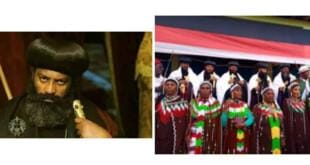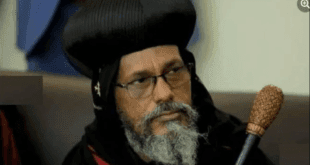http://www.dw.com/
In an interview with DW, a spokesman of the Ethiopian Federal Democratic Unity Forum accused the government of abusing the country’s constitution with its plans to expand the capital Addis Ababa.
Violence and chaos gripped Ethiopia this week as thousands of demonstrators took to the streets in protest against government plans to expand the capital Addis Ababa. Human Rights Watch said at least 75 people were killed in a bloody crackdown by heavily armed security forces. The demonstrations have spread to several towns since November, when students spoke out against plans to expand the capital into Oromia territory, a move the Oromo people consider a land grab. DW spoke to Merara Gundina, chairman of the opposition Oromo Federal Congress, in Addis Ababa.
DW: What exactly are you demonstrating against?
Merara Gundina: The Addis Ababa Master Plan is part of a larger land grab by the Ethiopian government around Addis Ababa, which has displaced not less than 200,000 people. Secondly, under federalism all the boundaries are being eroded by the ruling party which is bent on taking the land. People are very angry with the government and people who wanted to see change are frustrated.
Under the Ethiopian constitution all land belongs to the state, with people living there legally considered tenants. Doesn’t this allow the government to carry out any developments that may serve the interests of all Ethiopians?
No, no, the government is misusing it. The constitution says the land belongs to the public so it doesn’t allow the government simply to tell the people “go away” and it takes the land. No, it says there are bonds of state in the name of the people and there are individuals owning the land. It is the ruling party that is misusing the constitution. In fact, the state itself is privatising the country.
We understand you have vowed to continue the demonstrations despite the killings and Prime Minister Hailemariam Desalegn declared on television that the government would act without mercy. Is it not better to solve these issues through talks?
We continue to support the cause of our people. We continue our peaceful struggle. We cannot be intimidated as the government has done. We have popular support, we have millions of people behind us. The government cannot silence us easily. We are following the constitution but we are against the arbitrary misuse of the constitution by the ruling party. Our people will continue.
Is it true that your organization is getting support from outsiders?
The diaspora is far away. It’s school kids, high schools and universities and the government is simply accusing the left and the right. Probably the diaspora is very active in the media because the local media are totally controlled by the government. We have no access to the media and the diaspora have some media outlets and they report what is happening in the country. But a diaspora of a few thousand cannot move millions of people.






The hidden agenda was to become operational when the TPLF ostensibly called upon Ethiopian progressive forces in the so-called Addis Ababa Charter in 1991, where Isaais was also present. Isaais’ presence in the conference was not merely symbolic or a sign of solidarity; it was in fact meant to help and encourage Meles and the TPLF stay the course in Addis Ababa, because both of them were not sure whether the Ethiopian people would accept or reject the TPLF.
The Ethiopian people did not embrace the TPLF/EPRDF, but when the latter’s forces marched on Addis Ababa the people did not show resistance either. Still, Meles and Isaais were not confident; the Eritrean case was taken for granted because Isaais knew well that Eritreans love and support him and on top of this Isaais had witnessed the euphoria of the people that had gripped his country for so long. For some unknown reason, Eritreans (excluding the opposition) love Isaais even when he mistreats and abuse them, and the gathering of Eritreans at the Manhattan Center in New York on September 25, 2011 to show their affection and love to Isaais is good enough to conclude that Issais is idolized by his people.
In Ethiopia, on the contrary, the people were silent and the two leaders likened the silence to a dormant volcano. They were concerned that the Ethiopian people could rise up anytime and topple the EPRDF regime. In the event the Ethiopian people revolted and the TPLF/EPRDF is unable to rule over Ethiopia, the two leaders agreed to establish a Tigray-Eritrea state at the expense of dismantling Ethiopia. This did not happen, of course, but the agenda is still considered as an option by Meles and Isaais.
The other grand agenda that the two leaders concocted was that Meles preside over a weak Ethiopia without outlet to the sea and Isaais systematically turn Eritrea into a failed state. In other words, Eritrea was to commit infanticide while a divided Ethiopia breaks down into several states. Today, although Eritrea is not like Somalia, it is on the brink of a failed state; Ethiopia has not broken yet but given the ‘divide and rule’ policy of the EPRDF and the fragility of the Horn of Africa, the country may face the same fate of a failed state as well. To some extent, the joint agenda worked in Ethiopia and to a greater extent it became a reality in Eritrea.
The reason I say “to some extent” in relation to Meles’ agenda in Ethiopia is not because he did not try his best to dismantle Ethiopia but because he met strong challenges within his party, the TPLF, and other opposition parties in Ethiopia. Meles and the EPRDF allowed “elections” in Ethiopia (hypocrisy of the highest degree) because the people terrified them. In Eritrea, such scenario does not exit; Eritreans seem to be satisfied with the way Isaais governs Eritrea. Every time Meles imprison political opponents (like Seeye Abraha or Birtukan Medeksa), the Ethiopian people opposed the government and demanded the release of the prisoners. When Isaais imprisoned Petros Solomon, Mohammed Sherifo, and Haile W. Tensae (Durủ), Eritreans were silent. That is why Seeye and Birtukan are now freed and but Petros, Durủ, and others are languishing in prison in unknown location in Eritrea.
In all the intricate and messy politics that we have seen above, Meles and Isaais are not alone. They were accompanied from day one by patron cupids (messengers of the patron saint) who serve as consultants, ministers, government bureaucrats, university professors, and in some cases as preachers in churches and mosques alike (same like the missioners who came to Africa before the Europeans colonized it).
The patron cupids are recruited from all over, irrespective of nationality and religious backgrounds. Some of them work closely with Meles and Isaais and they are their official advisors; the rest of the cupids have acted as if they are in the opposition in order to hoodwink the real opposition. They are dangerous because they speak the language of the people and they were assigned to infiltrate the opposition at home and in the Diaspora, and that is why the Ethiopian and Eritrean opposition groups in the Diaspora were unable to secure unified and strong political organizations in the last two decades.
In conclusion, I like to reconfirm that the Meles-Isaais covenant is still on, although it could be in its diminished state. The objective of the covenant was sometime tarnished as a result of the Ethiopian-Eritrean war of 1998, when Ethiopia came out victorious in the war. Then, Meles and Isaais were caught by surprise because the Ethiopian people rose in unity to defend their country. But the covenant is still on and the symptoms are the following: Isaais’ Eritrea is trying its best to reestablish relations with neighboring countries; reenter the Inter-Governmental Agency for Development (IGAD) of the Horn of Africa regional development cooperation; reenter the African Union (AU) and reestablish its embassy in Addis Ababa. Moreover, Italy has recently brokered “a peaceful resolution to the conflict between Ethiopia and Eritrea,” and based on this pretext Meles and Issais are scheduled to meet in person. We will not be surprised if the two leaders pause for a photo opportunity. They have accomplished their mission, but they may face the rage of the people in the end and they may be forced to reprogram their amygdale of fight or flight. We have to wait and see.